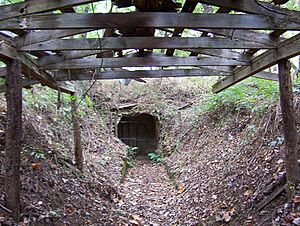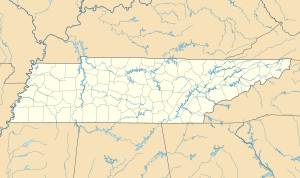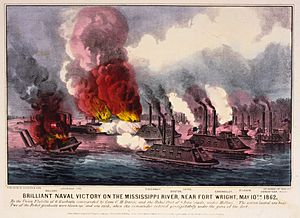Fort Wright (Tennessee) facts for kids
Quick facts for kids Fort Wright |
|
|---|---|
| Randolph, Tennessee | |

Entrance of the powder magazine at Fort Wright (2008)
|
|
| Coordinates | 35°31′16″N 89°53′15″W / 35.5211°N 89.8874°W |
| Site information | |
| Owner | Private |
| Open to the public |
No |
| Condition | The fort is destroyed, only a powder magazine is intact as of 2008 |
| Site history | |
| Built | 1861 |
| Built by | Confederate States Army |
| In use | 1861–1862 |
| Garrison information | |
| Past commanders |
Lieutenant Colonel Marcus Joseph Wright |
| Garrison | 5,000 troops in 1861 |
| Occupants | Nathan B. Forrest, Alexander P. Stewart |
Fort Wright was a military fort built in 1861. It was located on the second Chickasaw Bluff in Randolph, Tennessee, which is in Tipton County, Tennessee. This fort was an important fortification during the American Civil War. It was also the very first place in Tennessee where the Confederate Army trained its soldiers.
Building Fort Wright
In January 1861, a newspaper called the Memphis Appeal suggested building a fort at Randolph. This fort would help protect the city of Memphis from any attacks. On April 26, 1861, Brigadier General Gideon Johnson Pillow agreed. He told LeRoy Pope Walker, who was the first Secretary of War for the Confederacy, that Randolph was the best spot for a fort to defend Memphis.
Just a few days later, in late April, Tennessee's Governor Isham G. Harris gave an order. He told Lieutenant Colonel Marcus Joseph Wright to set up a camp at Randolph and finish building the fort. About 5,000 soldiers from Tennessee, Arkansas, and the Confederate Army worked together. It took them four months to build strong dirt walls and set up cannons. These defenses were meant to protect the fort from attacks both on land and from ships on the river.
By June 1861, the fort was not completely finished. However, 50 cannons were ready at Fort Wright. Most of these were large "thirty-two pounders," and some were even bigger. Thirty-two of them were already set up and ready to fire. The Memphis Bulletin newspaper visited the fort on June 22, 1861. They reported that the dirt walls were covered with grass and were very thick, about 20 to 30 feet (6–10 meters).
The Bulletin also noted that there was only one narrow path to the fort from the land side. This path was protected by heavy cannons and a thick dirt wall, about 30 to 40 feet (10–12 meters) wide. To the east, a curved wall, about 0.25 to 0.5 miles (400–800 meters) long, also helped defend against land attacks. Another Confederate fort nearby, Fort Randolph, was built a few months later in the fall of 1861.
Training Soldiers at Fort Wright
Many important Confederate leaders trained at Fort Wright. These included Nathan Bedford Forrest and Alexander P. Stewart. After his training, Stewart was promoted to Major in the "Tennessee Militia" by Governor Harris. He was put in charge of the large cannons and river defenses at Fort Wright. Stewart helped organize and train 20 groups of Tennessee artillery soldiers at the fort.
Both Forrest and Stewart later became very important generals in the Confederate Army during the Civil War. Other future leaders for the Army of Tennessee and Forrest's cavalry also received their training at Fort Wright.
Fort Wright was the first military training camp in Tennessee. Soldiers learned how to build forts and set up cannons to fight off naval attacks. They practiced defense drills and gained general military skills and discipline. Soldiers who trained at Fort Wright later fought in many major battles. These included the Battle of Shiloh, the Battle of Belmont, the Battle of Murfreesboro, the Battle of Chickamauga, the Battle of Franklin, and the Battle of Bentonville.
Fort Wright was the most advanced Confederate defense point on the Mississippi River until July 1861. The Confederate foot soldiers left the fort by 1862. However, other Southern forces sometimes used it during the Civil War.
Today, in 2008, only a powder magazine remains of Fort Wright.
Location
- Fort Wright (historical) was located at these coordinates: 35°31′16″N 89°53′15″W / 35.5211°N 89.8874°W.



